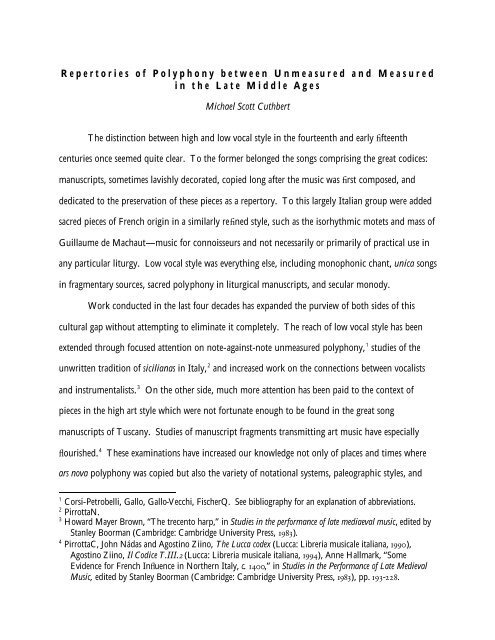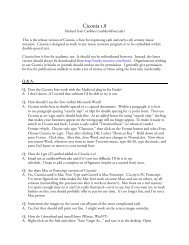Measured Early Polyphony - Trecento
Measured Early Polyphony - Trecento
Measured Early Polyphony - Trecento
You also want an ePaper? Increase the reach of your titles
YUMPU automatically turns print PDFs into web optimized ePapers that Google loves.
Repertories of <strong>Polyphony</strong> between Unmeasured and <strong>Measured</strong><br />
in the Late Middle Ages<br />
Michael Scott Cuthbert<br />
The distinction between high and low vocal style in the fourteenth and early fifteenth<br />
centuries once seemed quite clear. To the former belonged the songs comprising the great codices:<br />
manuscripts, sometimes lavishly decorated, copied long after the music was first composed, and<br />
dedicated to the preservation of these pieces as a repertory. To this largely Italian group were added<br />
sacred pieces of French origin in a similarly refined style, such as the isorhythmic motets and mass of<br />
Guillaume de Machaut—music for connoisseurs and not necessarily or primarily of practical use in<br />
any particular liturgy. Low vocal style was everything else, including monophonic chant, unica songs<br />
in fragmentary sources, sacred polyphony in liturgical manuscripts, and secular monody.<br />
Work conducted in the last four decades has expanded the purview of both sides of this<br />
cultural gap without attempting to eliminate it completely. The reach of low vocal style has been<br />
extended through focused attention on note-against-note unmeasured polyphony, 1 studies of the<br />
unwritten tradition of sicilianas in Italy, 2 and increased work on the connections between vocalists<br />
and instrumentalists. 3 On the other side, much more attention has been paid to the context of<br />
pieces in the high art style which were not fortunate enough to be found in the great song<br />
manuscripts of Tuscany. Studies of manuscript fragments transmitting art music have especially<br />
flourished. 4 These examinations have increased our knowledge not only of places and times where<br />
ars nova polyphony was copied but also the variety of notational systems, paleographic styles, and<br />
1 Corsi-Petrobelli, Gallo, Gallo-Vecchi, FischerQ. See bibliography for an explanation of abbreviations.<br />
2 PirrottaN.<br />
3 Howard Mayer Brown, “The trecento harp,” in Studies in the performance of late mediaeval music, edited by<br />
Stanley Boorman (Cambridge: Cambridge University Press, 1983).<br />
4 PirrottaC, John Nádas and Agostino Ziino, The Lucca codex (Lucca: Libreria musicale italiana, 1990),<br />
Agostino Ziino, Il Codice T.III.2 (Lucca: Libreria musicale italiana, 1994), Anne Hallmark, “Some<br />
Evidence for French Influence in Northern Italy, c. 1400,” in Studies in the Performance of Late Medieval<br />
Music, edited by Stanley Boorman (Cambridge: Cambridge University Press, 1983), pp. 193-228.



